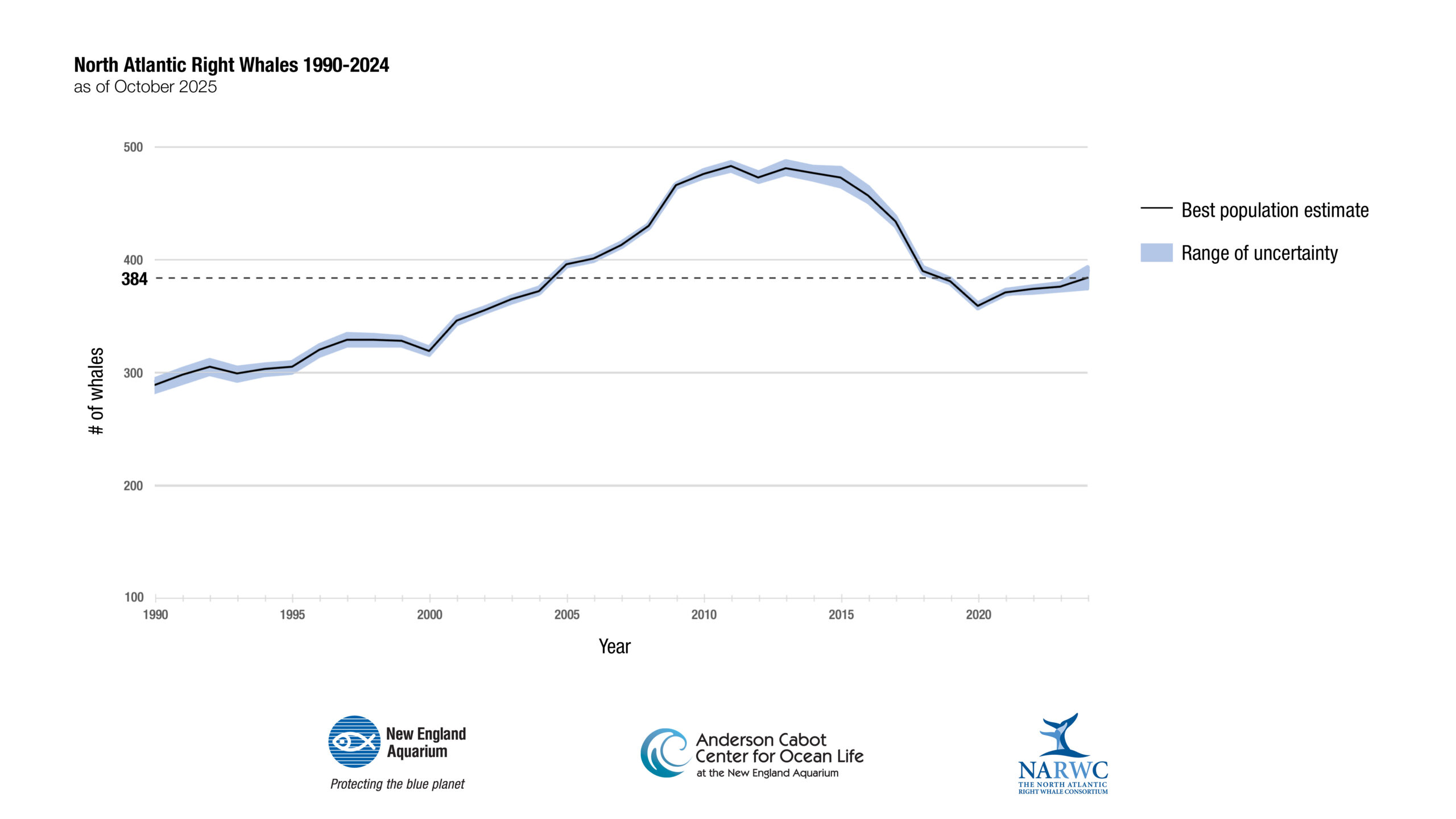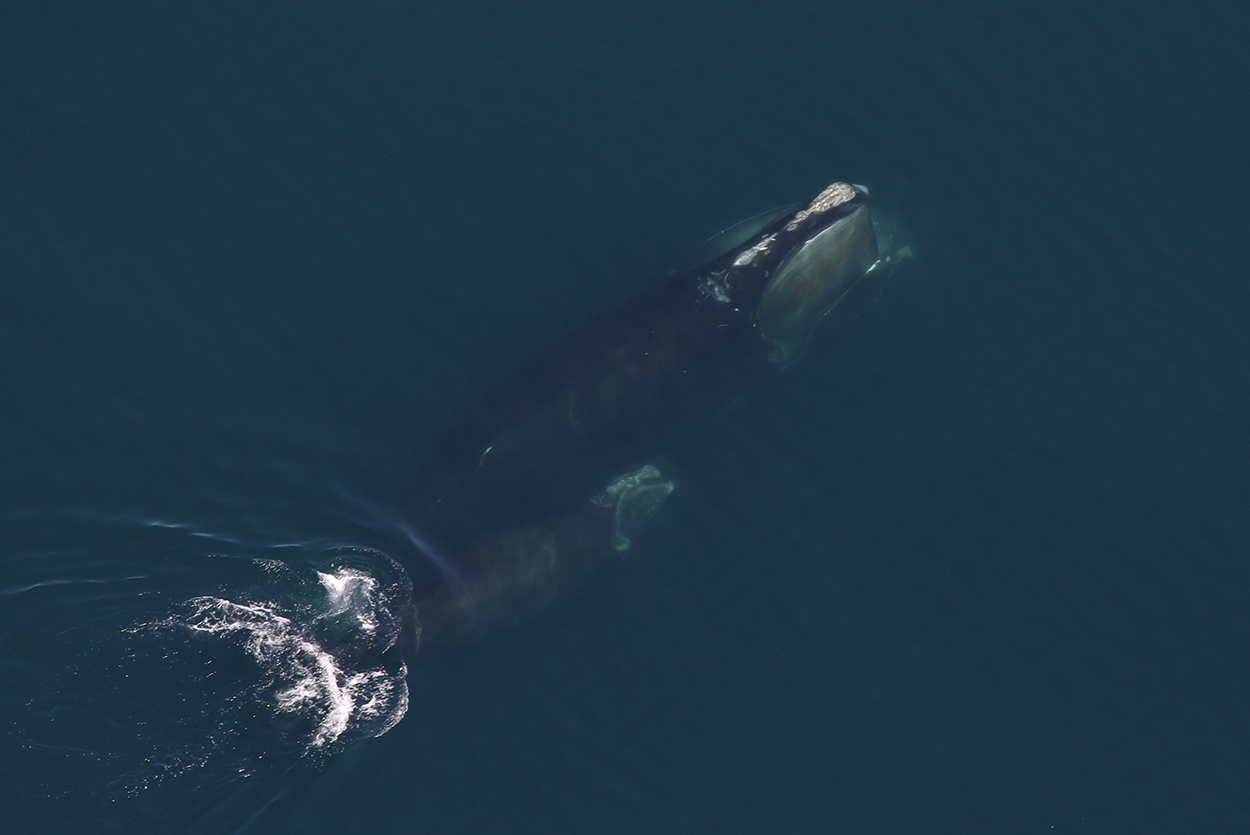Press Release: 10/21/2025
North Atlantic right whale population continues slow growth
Scientists share latest update while emphasizing the need for continued protection
North Atlantic right whale “Monarch” (Catalog #2460) was discovered with her new calf in Cape Cod Bay in April 2025 PHOTO: CENTER FOR COASTAL STUDIES, TAKEN UNDER NOAA PERMIT #25740-02
BOSTON, MASS. (Oct. 21, 2025) – The latest population estimate for the critically endangered North Atlantic right whale shows the species is heading in a positive direction, continuing a trend of slow growth over the past four years.
The North Atlantic Right Whale Consortium releases the updated population estimate for the species each year in coordination with its annual meeting, which is being held Oct. 22-23 in New Bedford, Mass. The estimate for 2024 is 384 (+10/-9 for range of error), representing a 2.1 percent increase in population size from the 2023 estimate, which was recalculated as 376 (+4/-3). Scientists from the New England Aquarium’s Anderson Cabot Center for Ocean Life and the National Oceanic and Atmospheric Administration (NOAA) collaborate to calculate the estimate, factoring in calves born within the last year.
“It’s always a great feeling when we can share positive news about this critically endangered species. The slight increase in the population estimate, coupled with no detected mortalities and fewer detected injuries than in the last several years, leaves us cautiously optimistic about the future of North Atlantic right whales,” said Heather Pettis, who leads the right whale research program in the Aquarium’s Anderson Cabot Center and chairs the North Atlantic Right Whale Consortium. “With small population increases year to year, we still need strong protective measures for continued growth. We don’t want to take our foot off the gas when it comes to management and conservation efforts.”

RW population numbers 1990-2024 NORTH ATLANTIC RIGHT WHALE POPULATION ESTIMATE 2024
Entanglements and vessel strikes are the leading causes of serious injury and death for North Atlantic right whales. Coming off a difficult year in 2024 that saw five right whale deaths, 16 entanglements (10 of which had attached fishing gear), and eight vessel strikes, this year has been a welcome relief. So far in 2025, scientists have logged no deaths, one new entanglement injury without attached fishing gear, and one vessel strike. While it is promising to see these low numbers, they do not tell the full story: There are still right whales from past years that remain entangled. There could also be additional entanglements found later this year, as 50 percent of entanglements in 2024 were detected in the latter half of the year—including four in December.
“Detecting entanglements is challenging as it requires two things to align: people to be looking and whales to be present in those times and locations where they’re looking. That’s why it is so important to have continued collaboration with state, federal, and private entities to ensure right whales are monitored throughout their range in the U.S. and Canada,” said Philip Hamilton, a senior scientist in the Aquarium’s Anderson Cabot Center.
One whale detected entangled in December 2024 far from shore is unnamed right whale Catalog #5110, who was spotted again in Cape Cod Bay in April of this year with fishing gear still attached. Multiple organizations were involved in efforts to relocate this whale. Although the Center for Coastal Studies’ Marine Animal Entanglement Response team was able to remove a small amount of gear, the whale was left with rope caught in his mouth.
“The case of Catalog #5110 is a sad reminder of not only the persistent challenges to the survival and recovery of this species but also the prolonged suffering these individual whales endure. The effort that went into trying to assist this animal was tremendous, and yet it remains carrying a life-threatening entanglement. The ultimate goal is to prevent these entanglements from happening in the first place,” said Pettis.
Right whale births and new mothers are cause for celebration each year, yet the 2025 calving numbers lagged behind what researchers had hoped for. Eleven calves were born, with four first-time mothers in the group. While most mother-calf pairs are detected in southeastern United States waters, two of this past season’s mothers were seen for the first time with their calves in unexpected places: “Accordion” (Catalog #4150) off New York in February and “Monarch” (Catalog #2460) in Cape Cod Bay in April.
“In recent years, right whales have been delaying giving birth to their first calf until they are older. It is encouraging to see four of these older females join the reproductive pool this year. The future of the species rests on their broad backs,” Hamilton said.
Started in 1986, the North Atlantic Right Whale Consortium includes research and conservation organizations, shipping and fishing industries, technical experts, U.S. and Canadian government agencies, and state and provincial authorities, all of whom are dedicated to the conservation and recovery of the North Atlantic right whale. More than 450 in-person and virtual attendees from all over the world are expected for this week’s Consortium meeting in New Bedford, Mass. Following its meeting, the Consortium will draft a comprehensive annual report on the status of the species; survey, management, and research activities; and recommendations for action. The report will be available early in 2025 and published on the Consortium website.
“The road to recovery for this population is long, and we look forward to continued collaborations with our partners to ensure the ocean is safer for right whales,” Pettis added.
MEDIA CONTACT: Pam Bechtold Snyder—617-686-5068; psnyder@neaq.org

